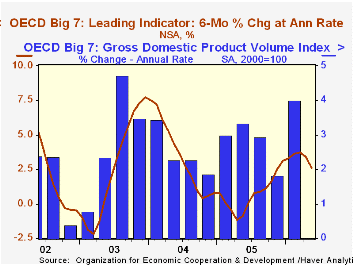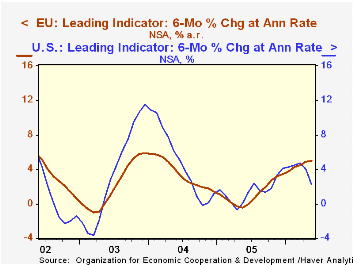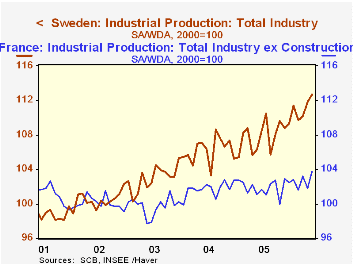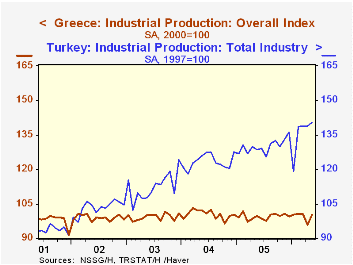 Global| Jul 10 2006
Global| Jul 10 2006OECD Leaders Slip, North America Down
by:Tom Moeller
|in:Economy in Brief
Summary
The Leading Index of the major 7 OECD economies slipped 0.1% during May and reversed a downwardly revised 0.1% gain the prior month. It was the first decline in the index since April of last year and it lowered the index's six month [...]

The Leading Index of the major 7 OECD economies slipped 0.1% during May and reversed a downwardly revised 0.1% gain the prior month. It was the first decline in the index since April of last year and it lowered the index's six month growth rate to 2.6%, the slowest since November.
During the last ten years there has been a 64% correlation between the change in the leading index and the q/q change in the GDP Volume Index for the Big Seven OECD countries.
A 0.6% decline in the U.S. leaders followed a 0.1% April dip and dropped the six month growth rate to 2.3%, its lowest since October. Consumer sentiment slipped and interest rate spreads remained quite negative. The correlation between the leaders' growth rate and real GDP growth has been a high 73% during the last ten years.
The Canadian leaders fell 0.9%. This fourth consecutive down month dropped the index's six month growth rate to -1.9%, the worst in year. The correlation of the leaders' growth with Canadian real GDP has been 49% during the last ten years.
The leading index for the European Union (15 countries) improved another 0.4%, about its monthly rate of advance since last Summer. The gain lifted the index's six month growth rate to 5.0%, the best in two years. During the last ten years there has been a 59% correlation between the change in the leading index and the quarterly change in the European Union GDP volume index.
The German leading index rose 0.6% after an upwardly revised 0.7% April increase. The six month growth rate, consequently, held at a firm 8.0%. During the last ten years there has been a 32% correlation between the change in the German leading index and the quarterly change in GDP volume.
The Italian leading index jumped 0.6%, the third strong monthly increase this year. It lifted the series' six month growth rate to 2.7% as the future tendency of production and new orders rose while consumer confidence was less negative.
A 0.1% increase in the leaders in France left the series' six month growth rate stable at a moderate, but improved, 2.8%.
The UK leaders ticked up 0.1% in May after a downwardly revised no change in April. The six month growth rate slipped to a modest 1.4% as consumer confidence fell.
The leading index in Japan gained 0.2% but April's previously reported sharp increase was revised down to 0.1%. The index's six month growth rate held at a moderate 1.7%. The leaders' correlation with Japan's real economic growth has been a meaningful 40% during the last ten years.
The latest OECD Leading Indicator report is available here.
Rising health costs put pressure on public finances, finds OECD can be found here.
| OECD | May | April | Y/Y | 2005 | 2004 | 2003 |
|---|---|---|---|---|---|---|
| Composite Leading Index | 105.27 | 105.42 | 3.2% | 102.85 | 102.38 | 97.99 |
| 6 Month Growth Rate | 2.6% | 3.4% | 0.7% | 3.5% | 2.6% |
by Louise Curley July 10, 2006

Four counties--France, Greece, Sweden and Turkey--released industrial production data for May this morning. France and Sweden are more highly developed in an economic sense than Greece and Turkey.
In France, where industrial production is only slightly higher than it was in 2000, industrial production rose from 101.7 in April to 103.7 in May. While Sweden showed a smaller increase from 111.8 in April to 112.7 in May, the level of production in Sweden is almost 13% above its 2000 level. The stronger trend in Sweden's industrial production compared with that of France is shown in the first chart.
Industrial production trends in Greece and Turkey show similar trends with Greece showing little growth since 2000 and Turkey, substantial growth. (The reported data for Turkey are based on 1997=100. We have adjusted these data to 2000=100) by changing the index base in the advanced function menu.) Production in Greece increased 4.7% in May from April, but was only 2.5% above May of 2005. Production in Turkey increased only 0.9% in May from April, but was 9.0% above May, 2005. Industrial production data for Greece and Turkey are shown in the second chart.
| Industrial Production (2000=100) | May 06 | Apr 06 | Mar 05 | M/M% | Y/Y % | 2005 | 2004 | 2003 |
|---|---|---|---|---|---|---|---|---|
| France | 103.7 | 101.7 | 101.0 | 1.96 | 2.67 | 101.8 | 101.6 | 99.6 |
| Sweden | 112.7 | 111.8 | 106.3 | 0.81 | 6.02 | 107.9 | 106.2 | 103.0 |
| Greece | 100.2 | 95.6 | 99.7 | 4.77 | 0.49 | 99.4 | 100.5 | 99.3 |
| Turkey | 135.7 | 134.4 | 124.4 | 0.94 | 9.01 | 125.7 | 119.3 | 108.7 |
Tom Moeller
AuthorMore in Author Profile »Prior to joining Haver Analytics in 2000, Mr. Moeller worked as the Economist at Chancellor Capital Management from 1985 to 1999. There, he developed comprehensive economic forecasts and interpreted economic data for equity and fixed income portfolio managers. Also at Chancellor, Mr. Moeller worked as an equity analyst and was responsible for researching and rating companies in the economically sensitive automobile and housing industries for investment in Chancellor’s equity portfolio. Prior to joining Chancellor, Mr. Moeller was an Economist at Citibank from 1979 to 1984. He also analyzed pricing behavior in the metals industry for the Council on Wage and Price Stability in Washington, D.C. In 1999, Mr. Moeller received the award for most accurate forecast from the Forecasters' Club of New York. From 1990 to 1992 he was President of the New York Association for Business Economists. Mr. Moeller earned an M.B.A. in Finance from Fordham University, where he graduated in 1987. He holds a Bachelor of Arts in Economics from George Washington University.






